The Final Circle: Diego dropped from TSM, how Respawn pays players with gifted subs, reactions to the Wild West meta
This is The Final Circle, a newsletter for competitive Apex
Diego dropped from TSM
Diego, previously one of the more popular Apex content creators, has been dropped from TSM. Photos of him kissing underage girls were widely shared on social media. Whether these are actually ‘stage kisses’, as some of his fans have asserted, hardly matters—the pattern of behavior described by his accuser in one video is creepy and entirely inappropriate.
Paying the price for speaking out
A former employee of Activision Blizzard, Christina “ZerinaX” Mikkonen, has accused the company of blacklisting her husband, the Hearthstone player Janne “Savjz” Mikkonen, because Christina had been critical of the company on social media. Soon afterward, Janne was no longer welcome at Hearthstone events. At first, Activision Blizzard spun a story about Janne not wanting to sign an NDA, prompting his exclusion from events. Janne immediately denied this.

The company has since issued a full apology to Janne and he is again allowed to attend Hearthstone events. Slimy, to say the least—threatening somone’s livelihood over legitimate complaints about the company.
Respawn hasn’t done anything so skeazy, as far as I know, but the community management of the Apex scene has its own methods of keeping players loyal.
How Respawn pays players with gifted subs
Game companies have long showered attention and money on streamers. Ninja and Shroud may have been paid millions of dollars to play Apex on release. On one level, it makes sense: streamers, who are valuable brands in themselves, are marketers of the game, and giving some form of compensation to them isn’t shocking—it might be the appropriate thing to do.
But now, as the Twitch community and esports world thinks more deliberately about the abuse of power structures and the standards of good conduct, it’s worth considering how Respawn has cultivated favor with popular Apex streamers and pros.
Most often, it’s been through indirect cash payments—the official Apex account gifting subscriptions to Twitch streamers. The most common amount is 50 subscriptions, or, at $5 per subscription, $250 (before Twitch takes its cut, usually between 40-50%).
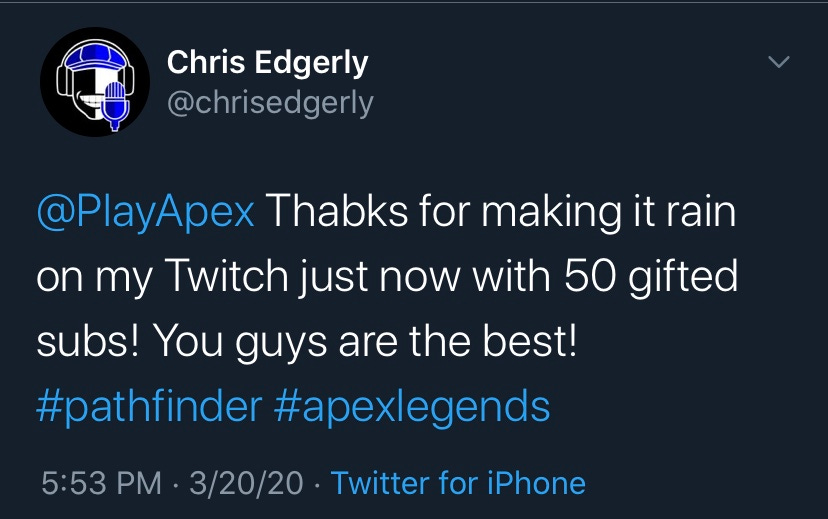
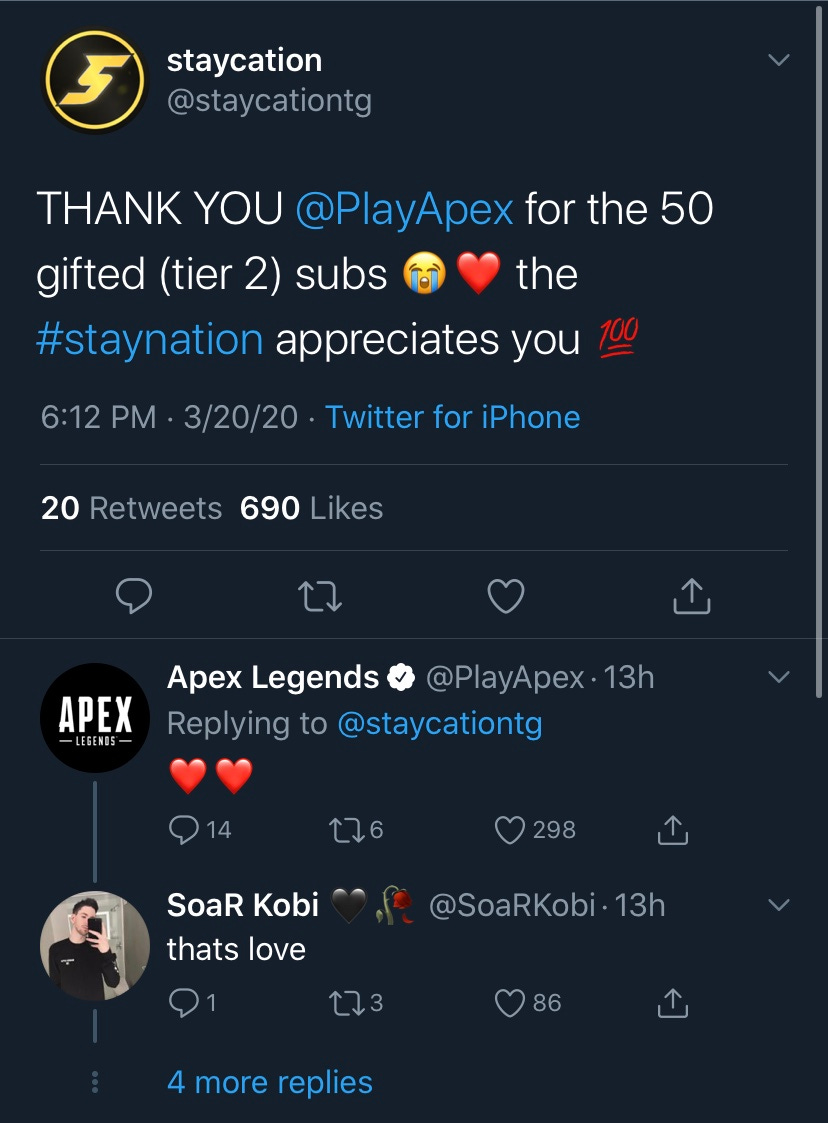
$125 isn’t an extravagant payment for a one-time social media shout-out using the official @PlayApex handle. But these donations can go much higher: sometimes to 100 subs, equal to around $250, or, as in the below example, repeated at higher levels: back in 2019 Mendo got $250 in his pocket, then received another gift of 100 subs at the higher ‘Tier 2’ price point, for a $1000 payday, of which he probably keeps around half.

Shroud was one of the early beneficiaries of Apex gifting subscriptions, netting 500 subscriptions or $2500, in one stream, in addition to whatever fee he was receiving to play the game.
This practice becomes problematic when you start to look at which streamers Respawn has been sweet on, and why—and who is excluded from these payments.
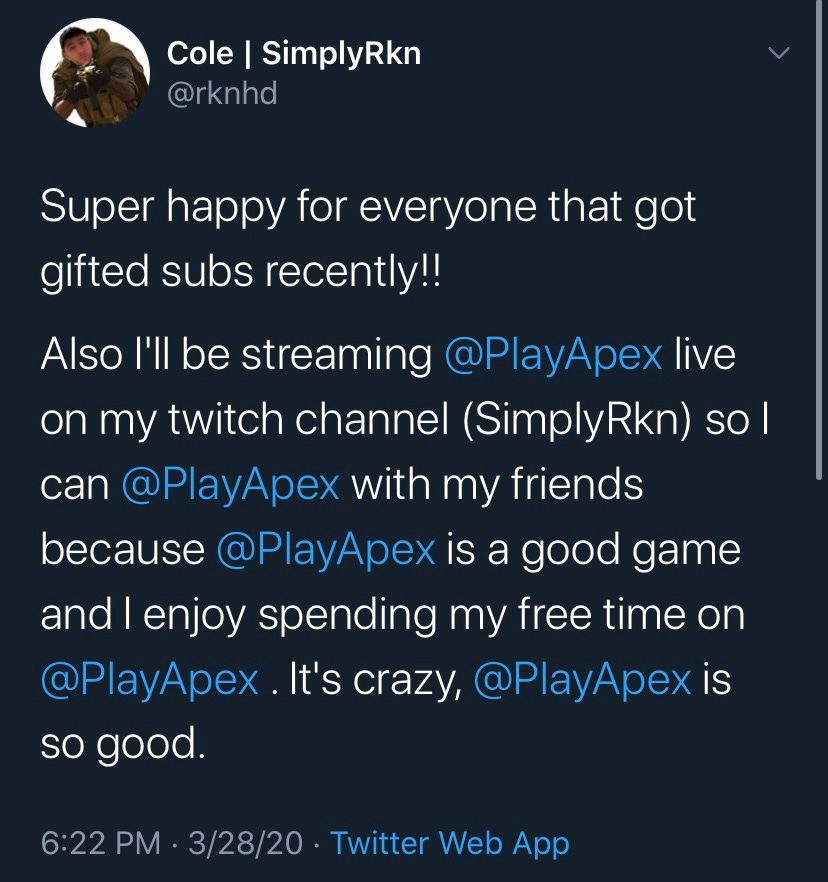
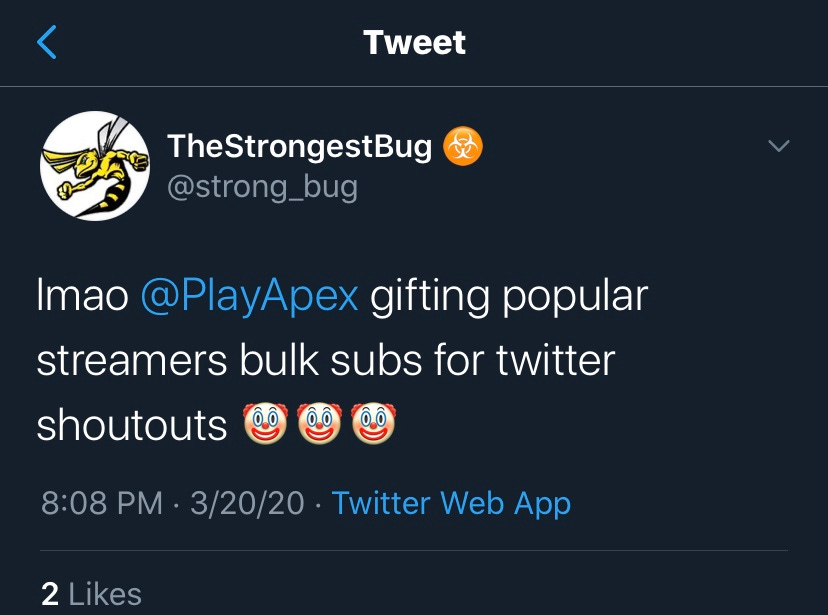
NiceWigg, for example, was highly critical of the game in March, and began streaming a lot of Call of Duty: Warzone, as well as playing in a Warzone tournament. Days later, he received a payment from the official Apex account of 50 ‘Tier 2’ subs, or $500.
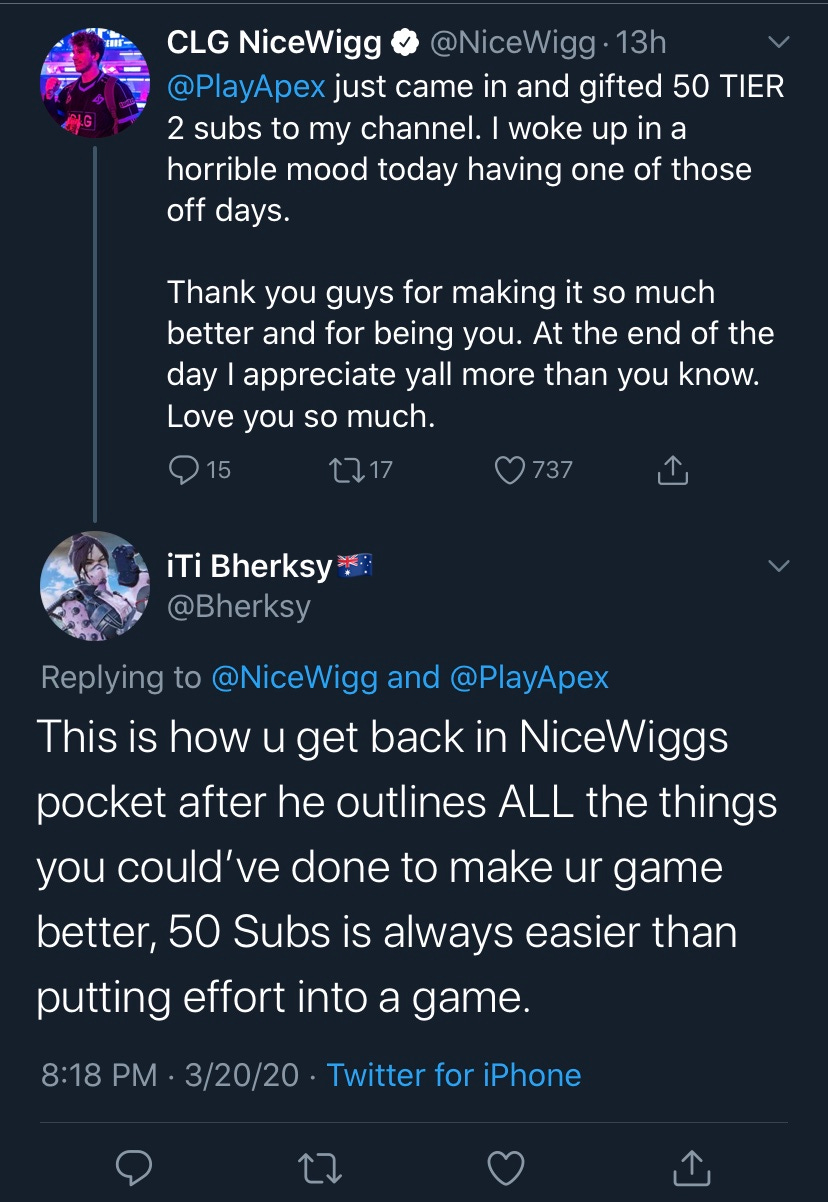
The payments continued. On the 28th of March, Apex gifted him 1000 subs, or a nice $5000 in revenue, of which NiceWigg almost certainly takes home more than half.

He has continued to be critical of Apex at times, but has also notably defended the brand—including during the no-reg debacle, which caused an astonishing number of shots to clink off enemies without damaging them, more or less breaking the game after a major update.
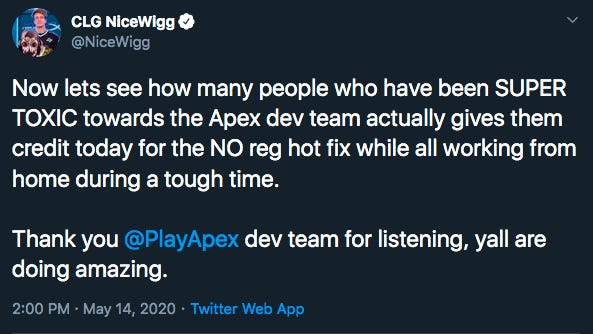
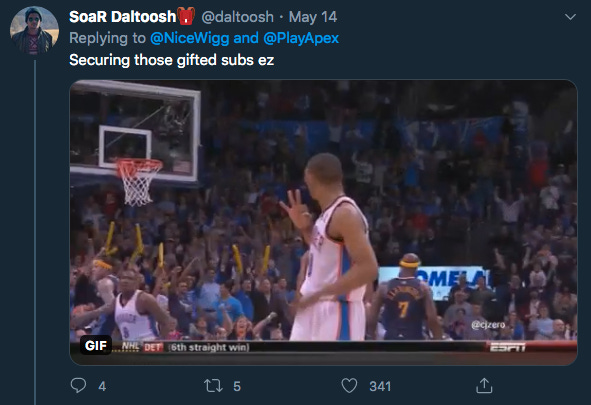
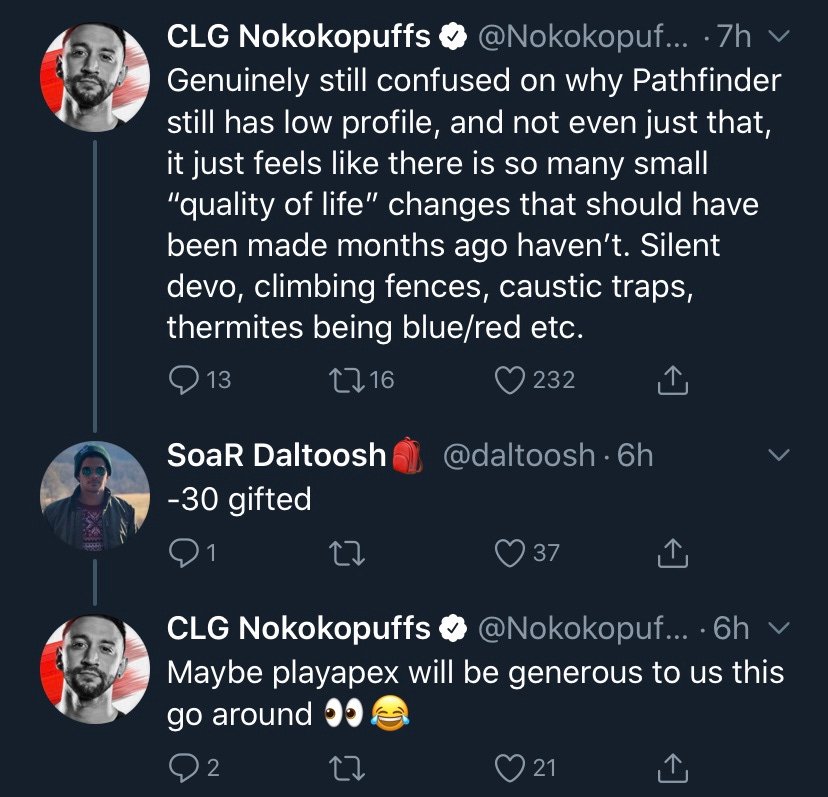
Daltoosh jokes, but he points toward a real issue. The possibility of receiving consistent informal payments like these fulfills two important roles for Respawn’s social media presence. It ensures the loyalty of bigger names who already support them, and it keeps smaller streamers, who crave the exposure and money they might receive from association with an official account, from being critical of the brand.
Reactions to the Wild West meta

Reactions have varied in response to the new meta. In many ways, it’s begun to play out like the classic dive meta you might have seen in Overwatch, with pushes to quickly shred an enemy team organized by the shield damage of Crypto’s EMP, Revenant’s Death Totem, or both.
With Wraith’s movement nerfed, Snip3down has talked on stream about Bloodhound possibly becoming viable, with an effective scouting ability every 25 seconds and a max range of around 75 meters (I still haven’t personally seen a Bloodhound in recent competitive play).
Others, best demonstrated in this reddit post by Hilmfur, have pushed back on the idea that reckless pushes will continue to dominate the meta—Rogue won the weekly Esports Arena tournament with an old-fashioned Pathfinder-Wattson-Wraith.
Saturday’s GLL qualifiers played out with a healthy mix of styles. TSM ran the aggressive Revenant/Wraith/Crypto, bullying other teams with EMP and Death Totem and taking some high kill games—enough to put them a few points ahead of the other major threat in their qualifying lobby, NiceWigg’s Yeet Squad. Yeet Squad ran a Caustic/Wraith/Path, using Caustic barrels to protect their territory instead of the more traditional Wattson/Wraith/Path.
Caustic is still a big winner of this patch, despite many people who believe that his utility is reduced the more Caustics are in the lobby. I wouldn’t be surprised to see Caustic replacing Wattson more often.
The big surprise on Saturday was Wraith, still central to the meta. Maybe the extra time she needs before she can escape into the void and the distance penalty on her tunnel won’t turn out to be such a devastating change after all.
Still too early to tell! We’ll have to see Monday and Tuesday’s results, and which playstyles thrive in the later rounds of the GLL tournament.



